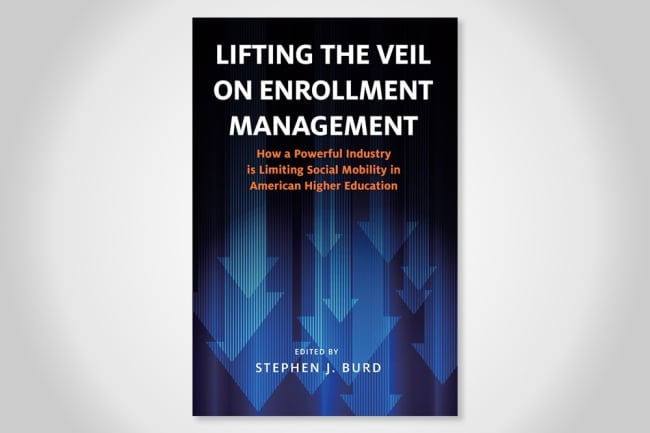You have /5 articles left.
Sign up for a free account or log in.

Harvard Education Press
In an opinion essay they wrote for this publication recently, Robert Massa and Bill Conley gently took issue with my book Lifting the Veil on Enrollment Management: How a Powerful Industry Is Limiting Social Mobility in American Higher Education (Harvard Education Press), arguing that my critique of the institutional financial aid strategies that the enrollment management industry promotes “is somewhat overstated.” More cutting was the headline of their column: “Is Enrollment Management Really Ruining Higher Ed?”
It is standard practice in Washington, D.C., public policy debates for supporters of the status quo to portray themselves as realists and reformers as naïve or conspiracy theorists. This approach echoes the infamous attack line that Ronald Reagan leveled at President Carter during the presidential debates of 1980: cocking his head toward Carter and chuckling, he said, “There you go again.”
It is important to say up front that I truly like and admire Robert Massa (I don’t know Bill Conley). By all accounts, he was an exemplary enrollment manager at Dickinson College, where he was dedicated to making the college more racially diverse. As Massa and Conley write, they had the good fortune of working at selective private colleges that were committed to meeting their students’ full financial need. They write that in their experience at such institutions, financial aid leveraging—an enrollment management practice in which colleges determine the precise price points, or tuition discounts, needed to enroll different groups of students, without spending a dollar more than necessary— was “primarily aimed” at just a subset of students with low or no need, and was “typically not used to determine the amount of institutional grants awarded to individual students with need.”
Unfortunately, their experiences aren’t typical. In fact, fewer than two dozen selective private colleges leverage their aid and meet 100 percent of their students’ financial need.
In reality the vast majority of colleges that engage in student aid leveraging do not meet the full financial need of their students. And many, if not most, of these colleges leave low- and lower-middle-income students with substantial amounts of unmet need, requiring these individuals and their families to take on heavy debt loads to enroll.
In an analysis I conducted for the book of institutional financial aid data at 575 selective private and public colleges and universities, I found that these institutions’ use of non-need-based aid skyrocketed from $2 billion annually in 2000 to more than $8 billion by 2020, after adjusting for inflation. Breaking these figures down by sector, I found the following:
- The 307 selective private colleges examined increased the annual amount they spent on non-need-based aid to $4.9 billion, from about $1.4 billion.
- The 268 selective public universities examined increased the yearly amount they spent on non-need-based aid to $3.3 billion, from $931 million.
At the same time that these selective colleges accelerated their spending on non-need-based aid, they left low-income and other financially needy students with larger funding gaps. Between 2000 and 2020, the average amount of financial need these colleges covered of their freshman student aid recipients dropped substantially: from 90 to 85 percent at private colleges and from 74 percent to 65 percent at public universities. A deeper dive into the data revealed that over this time period:
- Nearly two-thirds of the selective public universities examined decreased the amount of financial need they covered by an average of 18 percentage points.
- Nearly three-fifths of the selective private colleges examined decreased the amount of financial need they covered by an average of 11 percentage points.
Rather than pushing colleges to limit their use of financial aid leveraging to a subset of students, the country’s largest enrollment management firms are aggressively marketing financial aid leveraging (also called “optimization”) products that are designed to help colleges use all their aid strategically to pursue the students they most desire: the best applicants, who can help them rise up the rankings, and the wealthiest, who can help them increase their revenues.
EAB, one of the giants of the enrollment management industry, boasts to colleges that its “Financial Aid Optimization program ensures that every dollar you commit to aid is used to further your enrollment and net tuition revenue goals.” Instead of using student aid to meet financial need, the main goal of financial aid leveraging is to boost the institution’s bottom line. But don’t take it from me. Here’s what Nathan Mueller, a leader of EAB’s financial aid optimization team, recently told Higher Ed Dive: “The concept is to award financial aid in a way that results in the maximum total amount of net tuition revenue for the institution.” What this means in practice is that institutional financial aid dollars that used to go to financially needy students are now being used to provide discounts to entice affluent ones to enroll.
Joanne Bresilien learned that lesson the hard way, as the author Beth Zasloff writes in a chapter in my book. Raised by a single mother, who supported her two children on a monthly disability check, Joanne decided that she wanted to attend Ithaca College to pursue her goal of becoming a physical education teacher. While Ithaca provides generous discounts to affluent students, the college left Joanne, a low-income, first-generation student, with a substantial funding gap for her first year that could only be filled by having her mother take out a $14,000 federal Parent PLUS Loan.
Joanne is not alone. For colleges that leverage a substantial portion of their aid, PLUS loans are easy credit they can offer low-income families who are left with large funding gaps. Unlike federal student loans, which have strict borrowing limits, parents can borrow PLUS loans up to a college’s full cost of attendance (minus the cost of any aid awarded), regardless of their income. To obtain the loans, parents need only pass a lax adverse credit-history check that does not assess whether the borrower will be able to repay the debt. And because colleges are not held accountable if borrowers do default on this debt, the institutions don’t have to worry about how hazardous these loans may be for students’ families. As a 2019 Urban Institute report stated, the PLUS loan program is “a no-strings-attached revenue source for colleges and universities, with the risk shared only by parents and the government,” which loses money if borrowers default.
It would be one thing if selective colleges left students like Joanne with large funding gaps because of limited resources. Joanne believed that was the case at Ithaca until one who day when she ran into an affluent friend outside her dorm who complained about having to go to the financial aid office. “I don’t know why they’re giving me an extra $14,000, and I don’t need it,” her friend said. For Joanne, “hearing this number, the same amount as her gap, felt like a punch to the gut,” Zasloff writes.
The fact that families like Joanne’s need to take on such an extraordinary risk to attend colleges that are showering wealthy students with more money than they know what to do with should raise alarms. Policy makers need to take a good, hard look at the financial aid leveraging products, strategies and algorithms that the giant enrollment firms are marketing to determine whether they are putting low-income and other financially needy students in harm’s way.
Massa and Conley conclude their column by writing that “enrollment management provides an easy target to blame” and suggesting that little would change for low-income students “if enrollment management consulting firms and current practices were banned from college campuses tomorrow.” These longtime enrollment managers have a right to their opinion, but it seems premature to reach that conclusion until we have a much better idea of what these firms are selling.








